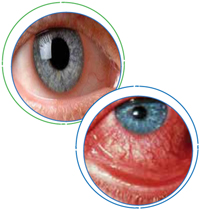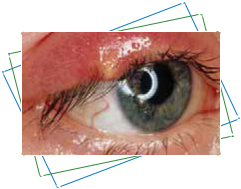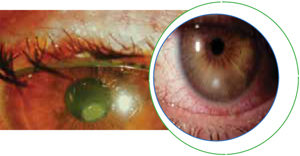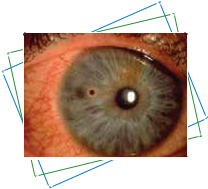Please find below contact details
and contact us today! Our experts always ready to help you.

Please find below contact details
and contact us today! Our experts always ready to help you.
 Conjunctivitis can be bacterial, viral or allergic.
Conjunctivitis can be bacterial, viral or allergic.
Symptoms
Gritty/itchy/foreign body sensation
Bacterial conjunctivitis often has mucopurulent discharge/lashes stuck together
Viral often watery, associated with cold/sore throat, pre-auricular lymph nodes
Blurring of vision due to disturbance of the tear film/corneal involvement (adenoviral)
Seasonal/hayfever allergic conjunctivitis
Signs
Redness affects all conjunctiva (globe of eye and tarsal conjunctiva lining inside of eyelids) in contrast to uveitis or scleritis where redness only on the globe
Purulent discharge suggests bacterial origin
Small white corneal infiltrates can occur in viral infection
Dry eye syndrome is a condition where the eyes do not make enough tears, or the tears evaporate too quickly. This can lead to the eyes drying out and becoming inflamed. It is a common condition and becomes more common with age, especially in women. up to a third of people aged 65 or older may have dry eye syndrome. It is more common in those with connective tissue disorders, in blepharitis and for contact lens wearers. Symptoms
Symptoms
Dry, gritty, discomfort or tired eyes which get worse throughout the day.
Mildly sensitive to light (not significant photophobia).
Slight blurred vision, which improves on blinking.
Both eyes are usually affected (may be asymmetrical symptoms).
Signs
Redness of the eyes
Spotty ("punctate") fluorescein staining
May be associated blepharitis (crusting of lashes, foamy tear film)
Blepharitis is an inflammatory eyelid condition caused by chronic staphylococcal infection and malfunction of the meibomian (lipid) glands. It can cause secondary conjunctivitis and dry eye, and occasionally small corneal ulcers. Symptoms
Symptoms
A gradual onset or chronic history of:
Gritty/sore eye
Crusting on lashes
Red eyes
Signs
Red rimmed, thickened lid margins +/- mild to severe crusting on the eyelashes
Blocked or oozing meibomian glands
Red conjunctiva in some cases
A chalazion is a firm round lump in the upper or lower eyelid caused by a chronic inflammation/blockage of the meibomian gland. unless acutely infected, it is harmless and nearly all resolve if given enough time. Symptoms
Symptoms
Eyelid swelling or lump.
Eyelid tenderness.
If inflamed, the eye can be red, watering and sore.
Signs
Tender or non-tender round swelling, can be red, on or within the
eyelid.
+/- mild conjunctivitis
A stye is a small abscess of the lash root on the eyelid. It appears as a painful yellow lump on the outside of the eyelid where the lash emerges. It is also known as an external hordeolum. Symptoms
Symptoms
Watery eye (epiphora)
Red eye and eyelid
Painful to touch
Signs
A small tender red swelling that appears along the outer edge of the eyelid, which may turn into a yellow pus-filled spot, centred on an eyelash follicle
Corneal abrasions are generally a result of trauma to the surface of the eye. Common causes include a fingernail scratching the eye, walking into a tree branch and getting dust in the eye, particularly if the eye is then rubbed. Injuries can also be caused by contact lens insertion and removal, but beware the possibility of a corneal ulcer in contact lens wearers, especially those who wear soft lenses. Symptoms
Symptoms
A gradual onset or chronic history of:
Immediate pain Watering
Foreign body sensation
Light sensitivity
Signs
Fluorescein drops will stain the abraded area.
Corneal foreign bodies are common. There may be a history of trauma, or using tools (eg hammering) without protective goggles or feeling something blow into the eye. Metal
foreign bodies can be very adherent and difficult to remove. Symptoms
Symptoms
A gradual onset or chronic history of:
Foreign body sensation
Watering
Pain
Ask about use of power tools and consider the possibility of an intraocular foreign body if high velocity injury
Signs
Visible corneal foreign body
Red eye
Contact lens stains with fluorescein
Sub tarsal foreign bodies (on the inner lid surface) are a common reason for attendance at an emergency eye clinic. They occur more commonly inside the upper eye lid. There mayss be a history of trauma or feeling something blow into the eye. Symptoms
Symptoms
A gradual onset or chronic history of:
Foreign body sensation
Watering
Pain
Signs
Visible sub-tarsal foreign body
Red eye
Linear corneal abrasion
A subconjunctival haemorrhage is caused by a bleeding blood vessel under the conjunctiva. Patients will often present after being told they have a red eye and may not have noticed any symptoms. Subconjunctival haemorrhages usually have no cause, but are more common after coughing or vomiting excessively. They can also be caused by mild trauma. Symptoms
Symptoms
A gradual onset or chronic history of:
Patients may describe a mild popping sensation in the eye prior to observing the redness
May describe a mild foreign body sensation or an eye ache
Usually symptom free
Signs
A flat, bright red haemorrhage in the conjunctiva
Episcleritis is a benign, self-limiting inflammatory disease affecting the episclera, the loose connective tissue between the conjunctiva and sclera, and causes mild discomfort. It is usually idiopathic and only rarely associated with systemic disease (eg rheumatoid arthritis). Symptoms
Symptoms
A gradual onset or chronic history of:
Mild ache/soreness of the eye
Eye is mildly tender to touch
Red eye
Signs
Segmental or focal redness which can be raised (nodular)
Redness disappears on compression and redness mobile on white of the eye with cotton bud – redness is neither mobile or compressible in scleritis
Eyes and eyesight are really God-gifted. Try closing your eyes for half an hour or at
least 10 minutes and you will realize the significance of eyes and vision. Like any
other part of your body, eyes too require conscious efforts to protect them, which
also help in improving your vision.
Taking proactive and conscious efforts to take care of your eyes will surely benefit
you in the long run. Here are some simple tips which you can follow, ensuring
maximum protection and care for your eyes.
Include more green veggies and fruits in diet: Following a healthy diet, rich with
fresh fruits, raw green vegetables, will benefit your body to be fit as well as your
eyes to be strong and sharp.
Adequate sleep: Night owls might not agree, but sure, they are risking their eye
health while sitting late night. Like your body, eyes too require adequate sleep
and rest at night, so that it can function properly without being puffy, red and
tired.
Maintain proper hygiene: Wash your hands properly before rubbing your eyes or
even touching your eyes. Those who wear contact lens should strictly follow the
hygiene instructions to avoid allergies and infections in eyes.
Regular eye check-up: It is highly recommended that you visit your eye
specialist, at least in a six months interval to make sure that your eyes are fit and
perfect, just like any other part of your body. Visiting your eye specialist at
regular intervals also help you to diagnose any problem related to your eyes, at
the initial phase itself, like myopia or cataract.
Quit smoking and liquor: Research show that smoking leads to damage of eye
muscles and tiny blood vessels, thus increasing the risks of age-related macular
degeneration (AMD), cataracts, glaucoma, diabetic retinopathy, dry eye
syndrome, and other conditions.
Wear sun glasses while in the sun: Sunlight is essential but not too much of it.
During dry hot days, avoid going out in the sun or look directly to strong sunrays.
Good quality sun shades and protective eye wear can help to protect your eyes
from external agents like strong light, UV rays, flashes etc.
Exercise regularly: Regular exercise not only keeps your body fit but also makes
your eyes healthy by pumping more blood and oxygen to your eyes.
i class="fa fa-check" aria-hidden="true"> Rest your eyes while at work: Majority of office jobs require constant and direct
glaring at the computer screen, making it difficult for your eyes. Make sure to
take a break, every twenty minutes. Just close your eyes or get some fresh air.
Avoid over-the- countertop medicines for eye infections: Most people resort to
instantly available over-the- top medications like eye drops or ointments for small
eye infections or allergies, which may later become fatal. Wash your eyes with
fresh water and even if the pain or irritation persists, consult your eye specialist.
Keep a safe distance from electronic screens: Adults are exposed to computer
screens at work place while kids are glued to TV screen at home, leading to eye
problems. Make sure that your TV is kept at a maximum distance while viewing.
Start prescribed eye drops, 4 times a day, in the eye to be operated, 2 days prior to surgery till the date of surgery.
Continue all your previous medications prescribed by your family physician or any other doctor, even on the day of surgery. Aspirin and related anti-platelet agents have to be stopped 5 days prior to surgery.
Take head bath before coming for surgery.
Please keep all your valuables at home before coming for surgery.
Don't change your food habits because of surgery. Follow everything as per your daily routine.
For persons with beard, it's better to shave off the beard before surgery.
Lens power (for cataract surgery) – Patient should get his /her IOL power evaluated before surgery. This facility is available at NSSEH all days except Sundays and Holidays. This test can be done any day before surgery, but if not done till 5:00 pm on the previous day, surgery will not be carried out on the scheduled days.
Patient should report to the hospital, accompanied by at least one adult and responsible relative, who has fair knowledge about patient's health.
Following things are to be carried along to the hospital:
NSSEH O.P.D File
Fitness certificate from M.D physician or M.D pediatrician for pediatric cases below 12 years of age.
Blood, Urine report, Sugar reports, HCV and HbsAg OR If any other reports required.
Patient should leave all valuables & jewellery / expensive watches etc. at home. The hospital will not be responsible for these items if lost or stolen.
After cataract surgery
Cataract surgery is considered a relatively straightforward day surgery procedure, with a patient returning home within several hours of the operation.
Immediately after cataract surgery
Before you leave the day surgery, you will be prescribed eye drops or other medication to prevent infection, reduce inflammation and control eye pressure.
You will need to have a family member or friend with you to take you home.
Once you get home, it is recommended that you rest your eyes and nap.
Several hours post surgery, most people are able to watch some television or look at a computer screen for a short period of time. Because cataract surgery is only performed on one eye at a time, you may notice an imbalance in your vision until the second eye is operated on (from 1–4 weeks later).
Days after cataract surgery
It is normal for vision to be blurry in the beginning – your eye needs to heal and adjust. Vision will normally begin to improve within a few days of the surgery. It's also normal for your eye to feel itchy and to experience mild discomfort for a couple of days – your doctor will ask you to wear an eye patch or protective shield at night to ensure you don't rub your eye while you sleep. This discomfort should disappear after a few days.
Weeks after cataract surgery
While everyone is different, the average experience for the weeks following cataract surgery involves a gradual recovery of the eye. Adjustments in vision will occur for a few months after surgery.
Following things are to be carried along to the hospital:
Don't do any strenuous activities for a few weeks. Avoid rigorous exercise and heavy lifting.
Don't drive. The length of time after cataract surgery before you can drive depends on a number of factors – your doctor will tell you when it is safe to resume driving.
Follow your doctor's orders regarding any antibiotic and anti-inflammatory eye drops. These are important to prevent infection and inflammation and ensure proper healing. If you have difficulty in administering them, get a friend or family member to help you out.
Stay away from dusty areas. It's a great idea to have your house vacuumed and cleaned before surgery, as your eyes will be sensitive to airborne allergens such as dust.
Don't rub your eye. Eye rubbing is a quick way to develop a nasty infection. It's never a good idea, even when you aren't recovering from surgery.
Don't swim. It's best to avoid swimming or hot tubs for a week after surgery.
Don't wear make-up. Ask your doctor when you can resume doing so.
Symptoms to watch for after cataract surgery
If you experience any of the following symptoms, please contact your ophthalmologist:
Vision loss
Pain that persists despite the use of over-the-counter pain medications
Light flashes or multiple spots (floaters) in front of your eye
Nausea, vomiting or excessive coughing
Patient Rights
Right to be treated with respect.
Right to freedom from discrimination, coercion, harassment, and exploitation.
Right to dignity and independence.
Right to services of an appropriate standard.
Right to effective communication.
Right to be fully informed about estimate cost of treatment, benefits vs risk .
Right to make an informed choice and give informed consent.
Right to support.
Right to change your hospital any time (on your risk which may be explained to you).
Right to complain to the management in appropriate mode.
Patient Responsibilities
Take part in the development of an individual care plan with nursing staff to enable your specific needs and cares to be met.
Provide the necessary information about your previous medical/surgical history to enable safe treatment and care.
Keep staff informed about any changes in your condition or situation.
Maintain your own health and function during your hospitalization, with assistance from nursing staff as necessary.
Respect the rights, needs, and dignity of other patients in the vicinity.
Be courteous to staff and respectful of their rights and professional opinion.
Respect organizational policies, i.e. safety, security, no smoking, individuals' privacy and confidentiality, visiting hours etc.
Treat hospital property with care and use only for the purpose for which it was designed.
Follow instructions of staff in the event of an emergency.
Help disabled & elderly patient ahead of your needs.
Maintain silence inside the hospital premises.
Restrict the number of attendants with you to 1 or 2 only.